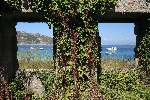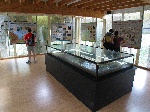Cies Islands
History
In ancient times the Cíes Islands were known as Siccae (arid). Archaeological remains have been discovered reflecting human presence since around 3500 B.C. However, remains of castro dwellings from the early Iron Age is evidence of the first known human settlement.
Evidence of Roman presence on the islands was found from remains such as a gold ring from the second century A. D. Other items found such as vases, pottery and various tools are on exhibit in the Museum of Pontevedra.
In the Middle Ages, the Cíes were inhabited by different orders of monks. The Benedictine order was there in the 11th century, later left but was to return at the end of the 18th century. In the 14th century the Franciscan order settled there, and the order of Cluny also spent time there. Evidence of this can be seen in the monasteries of San Estevo on O Faro Island and San Martiño on the island of the same name. There was also a salt works on top of which a restaurant was built.
One of the reasons the monks had to leave the islands was because they were under continuous attack, being so close to Vigo. There were attacks by Norman and Turkish pirates and invasions by fleets like that of the English under Francis Drake, and the islands were used as a base. This was to continue until the 18th century and led to the islands being abandoned.
Halfway through the 19th century the first lighthouse was built on the Isla de O Medio (O Faro Island). Around this time the island began to be populated again by families of fishermen and goat and sheep farmers.
In the 1960s the islands were finally abandoned and in the seventies and eighties people began to go to the islands to enjoy the beaches and the natural surroundings.
Concello de Vigo
Praza do Rei - 36202 - Vigo (Pontevedra) - Teléfono: 010 - 986810100




